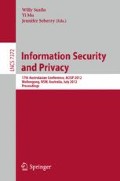Abstract
In this paper, we propose an IND-CCA2 secure code based encryption scheme in the standard model, built on the Niederreiter encryption scheme. The security of the scheme is based on the hardness of the Syndrome Decoding problem and the Goppa Code Distinguishability problem. The system is developed according to the construction similar to IND-CCA2 secure encryption scheme by Peikert and Waters using the lossy trapdoor functions. Compared to the existing IND-CCA2 secure variants due to Dowsley et.al. and Freeman et. al. (using the κ repetition paradigm initiated by Rosen and Segev), our scheme is more efficient as it avoids κ repetitions. This can be considered as the first practical code-based encryption scheme that is IND-CCA2 secure in the standard model.
This material is based upon work supported by the Summer Fellowship from Indian Statistical Institute Chennai.
Access this chapter
Tax calculation will be finalised at checkout
Purchases are for personal use only
Preview
Unable to display preview. Download preview PDF.
References
Agrawal, S., Boneh, D., Boyen, X.: Efficient Lattice (H)IBE in the Standard Model. In: Gilbert, H. (ed.) EUROCRYPT 2010. LNCS, vol. 6110, pp. 553–572. Springer, Heidelberg (2010)
Barreto, P.S.L.M., Misoczki, R., Simplício Jr., M.A.: One-time signature scheme from syndrome decoding over generic error-correcting codes. Journal of Systems and Software 84(2), 198–204 (2011)
Berson, T.A.: Failure of the McEliece Public-Key Cryptosystem under Message-Resend and Related-Message Attack. In: Kaliski Jr., B.S. (ed.) CRYPTO 1997. LNCS, vol. 1294, pp. 213–220. Springer, Heidelberg (1997)
Canetti, R., Goldreich, O., Halevi, S.: The random oracle methodology, revisited. J. ACM 51(4), 557–594 (2004)
Canetti, R., Halevi, S., Katz, J.: Chosen-Ciphertext Security from Identity-Based Encryption. In: Cachin, C., Camenisch, J.L. (eds.) EUROCRYPT 2004. LNCS, vol. 3027, pp. 207–222. Springer, Heidelberg (2004)
Diffie, W., Hellman, M.E.: New directions in cryptography. IEEE Transactions on Information Theory 22, 644–654 (1976)
Dolev, D., Dwork, C., Naor, M.: Nonmalleable cryptography. SIAM J. Comput. 30(2), 391–437 (2000)
Dowsley, R., Müller-Quade, J., Nascimento, A.C.A.: A CCA2 Secure Public Key Encryption Scheme Based on the McEliece Assumptions in the Standard Model. In: Fischlin, M. (ed.) CT-RSA 2009. LNCS, vol. 5473, pp. 240–251. Springer, Heidelberg (2009)
Faugére, J.-C., Otmani, A., Perret, L., Tillich, J.-P.: Algebraic Cryptanalysis of McEliece variants with compact keys – toward a complexity analysis. In: SCC 2010: Proceedings of the 2nd International Conference on Symbolic Computation and Cryptography, pp. 45–55. RHUL (June 2010)
Finiasz, M., Sendrier, N.: Security Bounds for the Design of Code-Based Cryptosystems. In: Matsui, M. (ed.) ASIACRYPT 2009. LNCS, vol. 5912, pp. 88–105. Springer, Heidelberg (2009)
Fischer, J.-B., Stern, J.: An Efficient Pseudo-random Generator Provably as Secure as Syndrome Decoding. In: Maurer, U.M. (ed.) EUROCRYPT 1996. LNCS, vol. 1070, pp. 245–255. Springer, Heidelberg (1996)
Freeman, D.M., Goldreich, O., Kiltz, E., Rosen, A., Segev, G.: More Constructions of Lossy and Correlation-Secure Trapdoor Functions. In: Nguyen, P.Q., Pointcheval, D. (eds.) PKC 2010. LNCS, vol. 6056, pp. 279–295. Springer, Heidelberg (2010)
Niederreiter, H.: Knapsack-type cryptosystems and algebraic coding theory. Prob. Contr. Inform. Theor. 15, 159–166 (1986)
Håstad, J.: Solving simultaneous modular equations of low degree. SIAM J. Comput. 17(2), 336–341 (1988)
Kobara, K., Imai, H.: Semantically Secure McEliece Public-Key Cryptosystems-Conversions for McEliece PKC. In: Kim, K. (ed.) PKC 2001. LNCS, vol. 1992, pp. 19–35. Springer, Heidelberg (2001)
Li, Y.X., Deng, R.H., Wang, X.M.: On the equivalence of McEliece’s and Niederreiter’s public-key cryptosystems. IEEE Transactions on Information Theory 40(1), 271–273 (1994)
Naor, M., Yung, M.: Public-key cryptosystems provably secure against chosen ciphertext attacks. In: STOC, pp. 427–437. ACM (1990)
Nojima, R., Imai, H., Kobara, K., Morozov, K.: Semantic security for the McEliece cryptosystem without random oracles. Des. Codes Cryptography 49(1-3), 289–305 (2008)
Peikert, C., Waters, B.: Lossy trapdoor functions and their applications. In: Dwork, C. (ed.) STOC, pp. 187–196. ACM (2008)
Rackoff, C., Simon, D.R.: Non-interactive Zero-Knowledge Proof of Knowledge and Chosen Ciphertext Attack. In: Feigenbaum, J. (ed.) CRYPTO 1991. LNCS, vol. 576, pp. 433–444. Springer, Heidelberg (1992)
Rivest, R.L., Shamir, A., Adleman, L.M.: A method for obtaining digital signatures and public-key cryptosystems (reprint). Commun. ACM 26(1), 96–99 (1983)
McEliece, R.J.: A public-key cryptosystem based on algebraic coding theory. JPL DSN Progress Report, 114–116 (1978)
Rosen, A., Segev, G.: Chosen-Ciphertext Security via Correlated Products. In: Reingold, O. (ed.) TCC 2009. LNCS, vol. 5444, pp. 419–436. Springer, Heidelberg (2009)
Shor, P.W.: Polynomial-time algorithms for prime factorization and discrete logarithms on a quantum computer. SIAM J. Comput. 26(5), 1484–1509 (1997)
Author information
Authors and Affiliations
Editor information
Editors and Affiliations
Rights and permissions
Copyright information
© 2012 Springer-Verlag Berlin Heidelberg
About this paper
Cite this paper
Preetha Mathew, K., Vasant, S., Venkatesan, S., Pandu Rangan, C. (2012). An Efficient IND-CCA2 Secure Variant of the Niederreiter Encryption Scheme in the Standard Model. In: Susilo, W., Mu, Y., Seberry, J. (eds) Information Security and Privacy. ACISP 2012. Lecture Notes in Computer Science, vol 7372. Springer, Berlin, Heidelberg. https://doi.org/10.1007/978-3-642-31448-3_13
Download citation
DOI: https://doi.org/10.1007/978-3-642-31448-3_13
Publisher Name: Springer, Berlin, Heidelberg
Print ISBN: 978-3-642-31447-6
Online ISBN: 978-3-642-31448-3
eBook Packages: Computer ScienceComputer Science (R0)

